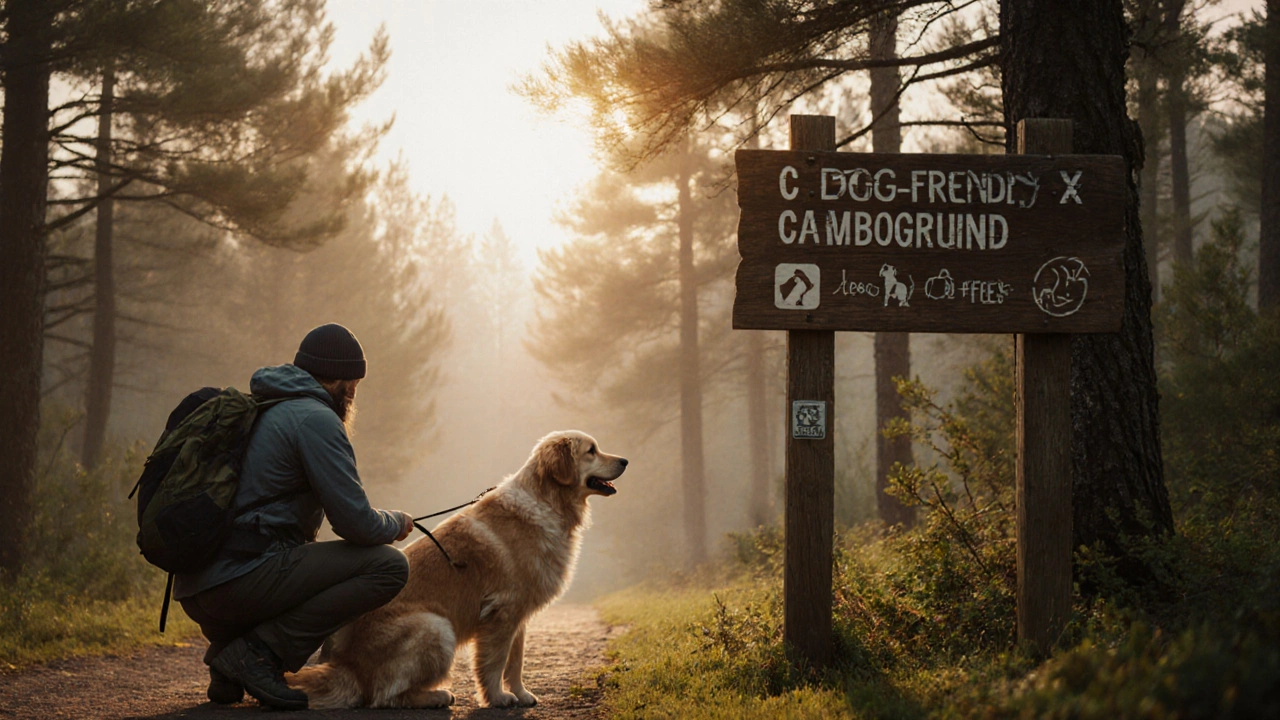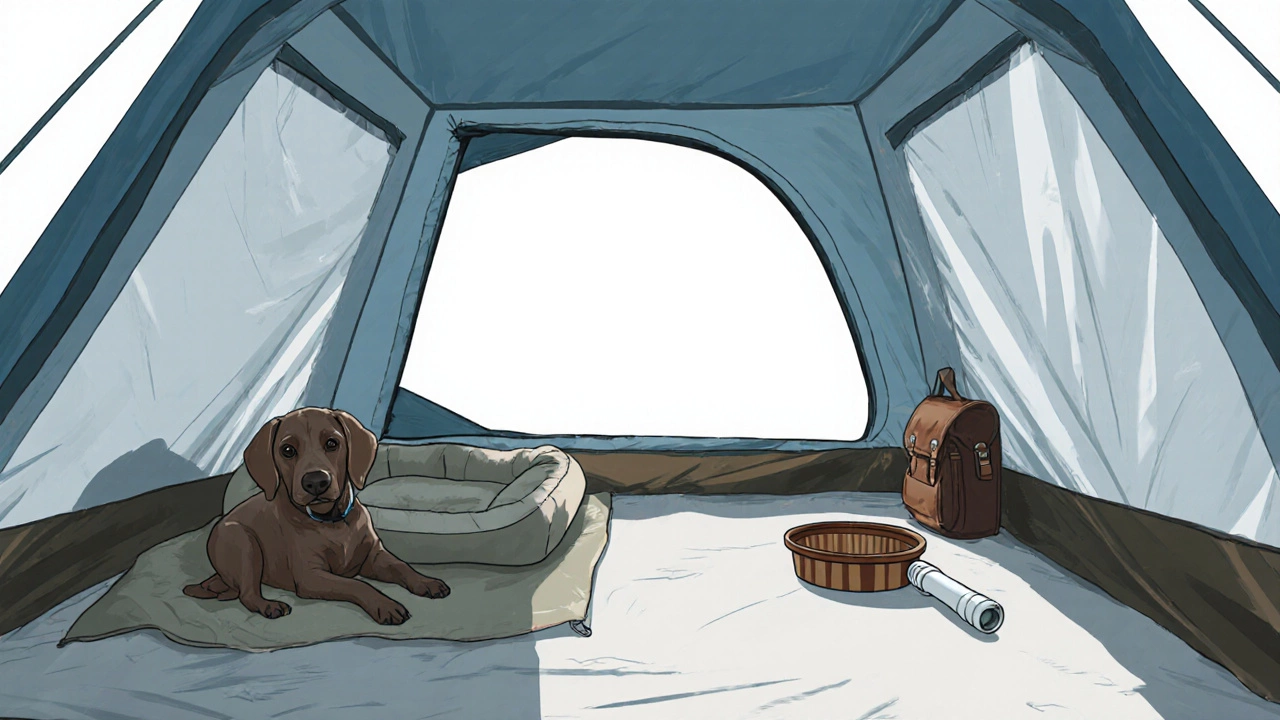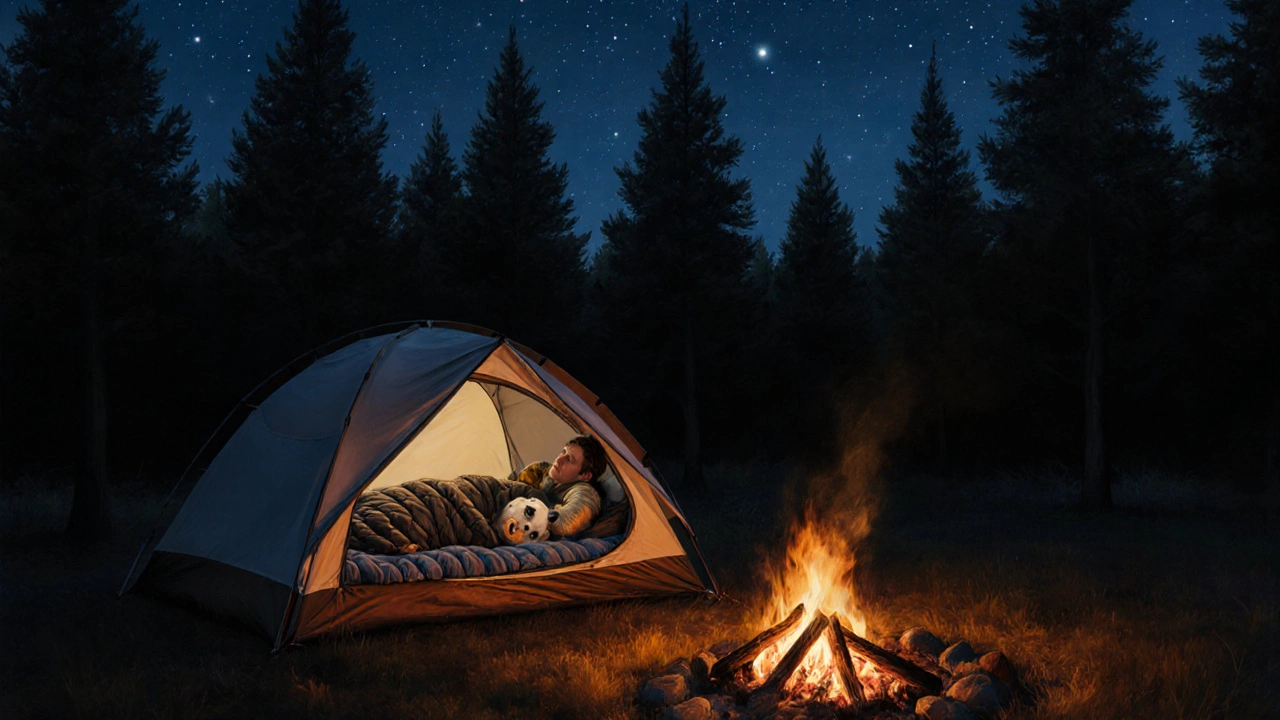Camping with Dogs: Can You Sleep in a Tent with Your Dog?
 Oct, 22 2025
Oct, 22 2025
Tent Size Calculator for Camping with Dogs
Calculate Your Dog's Tent Space
Based on article recommendations (8 sq ft per dog + buffer space)
When you plan a trip, Dog-friendly camping is the practice of bringing your canine companion along to camp outdoors, following specific rules and using gear suited for pets. It sounds great, but many wonder if sharing a tent with a dog is practical, safe, and even allowed. Below you’ll get the full picture - from legal basics and gear picks to nighttime routines and a ready‑to‑print checklist.
What Makes a Camp Spot Truly Dog‑Friendly?
Not every campground welcomes dogs, and those that do often have different policies. A Campground is a designated area that provides facilities like toilets, fire pits, and sometimes pet‑specific amenities may allow dogs on leashes only, charge a pet fee, or outright ban certain breeds. Check the site’s website before you book - look for a “Pet Policy” section that lists leash length, waste disposal rules, and any extra charges.
Legal and Safety Basics
The biggest rule you’ll run into is the Leash law a local regulation that dictates whether pets must be leashed in public outdoor areas. In many Australian national parks, dogs must be on a 2‑meter leash at all times. Breaking the rule can result in fines up to $200 and may bar you from returning.
Besides local laws, follow these safety habits:
- Vaccinate and de‑worm your Dog a domesticated canine companion, usually kept as a pet at least two weeks before the trip.
- Carry a copy of your pet’s health certificate; many parks request proof of rabies vaccination.
- Bring a portable Pet travel insurance coverage that helps pay for unexpected vet costs while traveling in case of injury or illness.
Choosing the Right Tent and Gear for Your Dog
A regular two‑person tent works, but you’ll want a few upgrades to keep both of you comfortable.
- Spacious floor plan: Look for a tent with a footprint of at least 8 sq ft of floor space per dog.
- Ventilation: Mesh windows reduce humidity, which is key when a warm‑breathed pup sleeps inside.
- Floor protection: A groundsheet or a lightweight tarp under the tent prevents mud from tracking in.
Inside the tent, consider these pet‑specific items:
- Dog bed a cushioned pad or portable crate that gives a dog a familiar sleeping surface - a folded foam pad works well.
- A collapsible water bowl and a small cooler for fresh water; dogs can overheat quickly at night.
- A short leash or harness attached to a stake, so you can quickly secure the dog if it gets restless.

Finding Dog‑Friendly Campsites
Here’s a quick rundown of the most common campsite types you’ll encounter and what they typically allow.
| Type | Pet policy | Fees | Facilities | Typical rules |
|---|---|---|---|---|
| National Park government‑managed natural areas with protected wildlife | Leashed only, breed restrictions in some parks | Optional $5‑$15 pet fee | Toilets, fire pits, marked trails | Keep dogs on leash, clean up waste |
| State Park regional parks administered by state governments | Leash 2 m, some off‑leash areas | $3‑$10 pet fee | Showers, picnic tables, sometimes dog runs | No aggressive breeds, waste must be packed out |
| Private campground commercial sites that charge for pitches and amenities | Often off‑leash zones, pet‑friendly cabins | $10‑$30 pet surcharge | Full hookups, dog‑friendly trails, pet‑washing stations | Quiet hours, no dogs in shared bathrooms |
| Wild camping camping outside designated sites, usually in remote areas | Depends on regional law; often unrestricted | No fee | None | Leave no trace, keep dogs under control, respect wildlife |
Setting Up Camp for a Good Night’s Sleep
Once you’ve arrived, follow these steps to make the tent comfortable for both you and your dog:
- Clear the ground of sharp rocks and sticks - your dog will be exploring the perimeter.
- Pitch the tent facing a natural windbreak; wind can chill a dog’s paws.
- Lay down the Dog bed in a corner where the dog can see the door.
- Set up a small, fire‑proof bowl with fresh water within arm’s reach.
- If you plan to have a Campfire an open fire used for warmth and cooking at a campsite, keep the dog on a leash at least 2 m away to avoid accidental burns.
Before lights out, give your dog a chance to “go” outside. Most pups need a bathroom break within 30 minutes of settling in.
Night‑time Routine and Comfort Tips
Dogs are pack animals and often feel uneasy when isolated. Here’s how to keep calm:
- Noise: White‑noise apps or a low‑volume fan can mask rustling leaves that might startle a dog.
- Temperature: In colder weather, consider a weighted dog blanket; in heat, ensure the tent is well‑ventilated and keep water bottles handy.
- Separation anxiety: A favorite toy or a piece of your clothing can reassure a nervous dog.

Common Pitfalls and How to Avoid Them
Even seasoned campers run into snags. Spot them early and fix them fast.
| Issue | Solution |
|---|---|
| Excessive barking | Provide a chew toy and stick to a bedtime routine. |
| Chewing gear | Use a chew‑proof camping mat and keep toys separate. |
| Midnight bathroom trips | Take the dog out right before lights out and use a portable pee pad as backup. |
| Heat stress | Camp in shade, keep water flowing, and avoid tent interiors during midday. |
Ultimate Pre‑Trip Checklist
- Vaccination records and health certificate
- Pet travel insurance policy copy
- Leash (2 m), harness, and extra collar with ID tag
- Portable dog bed or crate
- Collapsible water bowl + at least 2 L of water per dog
- High‑energy dog food, treats, and a small stash of human snacks
- Poop bags and a sealed bag for waste
- First‑aid kit (including paw balm, tick remover, antiseptic wipes)
- Tent with good ventilation and groundsheet
- Flashlight/headlamp with extra batteries
- Map of the campsite and local leash‑law regulations
Run through the list the night before; a missed item can turn a perfect night into a scramble.
Final Thoughts
Yes, you can absolutely sleep in a tent with a dog - you just need to respect the rules, bring the right gear, and give your pup a calm routine. With the steps above, you’ll enjoy the starry sky, the smell of pine, and your dog’s content snores all in one memorable night.
Can I leave my dog inside the tent unattended?
Only for short periods. Dogs can get anxious or overheat. If you need to step away, keep the tent door open a crack and bring a water bowl.
Are there any breed restrictions for dog‑friendly campsites?
Many national and state parks ban breeds deemed aggressive (e.g., pit bulls, dingo hybrids). Always check the site’s policy before booking.
How much water should I bring for my dog?
Plan on at least 1 L of fresh water per 10 kg of dog weight each day, plus extra for hot weather.
Do I need a separate sleeping pad for my dog?
A thin foam pad or a folded blanket works. The key is a clean, insulated surface to keep paws warm.
What’s the best way to keep my dog from digging up the campsite?
Place a mat or a piece of tarp in the spot where the dog sleeps. Provide a chew toy to distract from digging.